The Cal 2 46 is a 45.5ft masthead sloop designed by C. William Lapworth and built in fiberglass by Jensen Marine/Cal Boats between 1971 and 1975.
129 units have been built..
The Cal 2 46 is a moderate weight sailboat which is under powered. It is not stiff and has an excellent righting capability if capsized. It is best suited as a heavy bluewater cruising boat. The fuel capacity is excellent. There is a good water supply range.
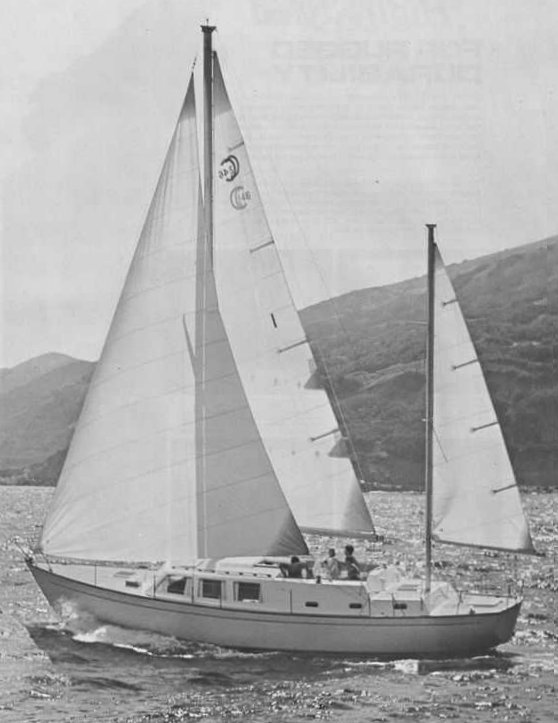

Cal 2 46 for sale elsewhere on the web:

Main features
| Model | Cal 2 46 | ||
| Length | 45.50 ft | ||
| Beam | 12.50 ft | ||
| Draft | 5 ft | ||
| Country | United states (North America) | ||
| Estimated price | $ 0 | ?? |
Login or register to personnalize this screen.
You will be able to pin external links of your choice.

See how Sailboatlab works in video
| Sail area / displ. | 13 | ||
| Ballast / displ. | 26.67 % | ||
| Displ. / length | 253.97 | ||
| Comfort ratio | 40.21 | ||
| Capsize | 1.61 |
| Hull type | Monohull fin keel with spade rudder | ||
| Construction | Fiberglass | ||
| Waterline length | 37.50 ft | ||
| Maximum draft | 5 ft | ||
| Displacement | 30000 lbs | ||
| Ballast | 8000 lbs | ||
| Hull speed | 8.21 knots |

We help you build your own hydraulic steering system - Lecomble & Schmitt
| Rigging | Masthead Sloop | ||
| Sail area (100%) | 781 sq.ft | ||
| Air draft | 0 ft | ?? | |
| Sail area fore | 432 sq.ft | ||
| Sail area main | 349.10 sq.ft | ||
| I | 48 ft | ||
| J | 18 ft | ||
| P | 40.08 ft | ||
| E | 17.42 ft |
| Nb engines | 1 | ||
| Total power | 0 HP | ||
| Fuel capacity | 270 gals |
Accommodations
| Water capacity | 170 gals | ||
| Headroom | 0 ft | ||
| Nb of cabins | 0 | ||
| Nb of berths | 0 | ||
| Nb heads | 0 |
Builder data
| Builder | Jensen Marine/Cal Boats | ||
| Designer | C. William Lapworth | ||
| First built | 1971 | ||
| Last built | 1975 | ||
| Number built | 129 |
Other photos
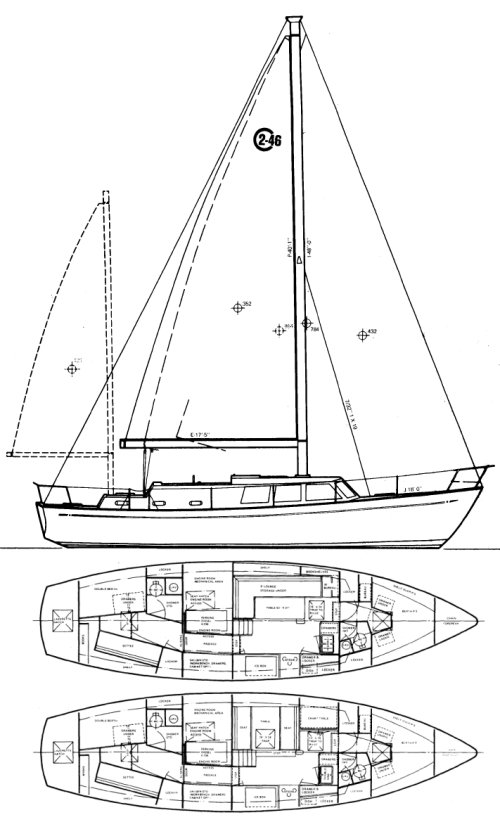
Modal Title
The content of your modal.
Personalize your sailboat data sheet
- New Sailboats
- Sailboats 21-30ft
- Sailboats 31-35ft
- Sailboats 36-40ft
- Sailboats Over 40ft
- Sailboats Under 21feet
- used_sailboats
- Apps and Computer Programs
- Communications
- Fishfinders
- Handheld Electronics
- Plotters MFDS Rradar
- Wind, Speed & Depth Instruments
- Anchoring Mooring
- Running Rigging
- Sails Canvas
- Standing Rigging
- Diesel Engines
- Off Grid Energy
- Cleaning Waxing
- DIY Projects
- Repair, Tools & Materials
- Spare Parts
- Tools & Gadgets
- Cabin Comfort
- Ventilation
- Footwear Apparel
- Foul Weather Gear
- Mailport & PS Advisor
- Inside Practical Sailor Blog
- Activate My Web Access
- Reset Password
- Customer Service

- Free Newsletter

Mason 33 Used Boat Review

Beneteau 311, Catalina 310 and Hunter 326 Used Boat Comparison

Maine Cat 41 Used Boat Review

Cheoy Lee Clipper 36 & 42 Used Boat Review

Tips From A First “Sail” on the ICW

Tillerpilot Tips and Safety Cautions

Best Crimpers and Strippers for Fixing Marine Electrical Connectors

Thinking Through a Solar Power Installation

Stopping Mainsheet Twist

Working with High-Tech Ropes
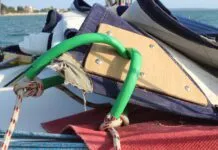
Getting a Clue for the Blown-Out Clew
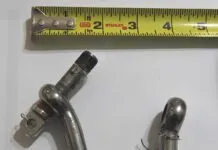
Monel Seizing Wire is Worth the Extra Cost

Fuel Lift Pump: Easy DIY Diesel Fuel System Diagnostic and Repair

Ensuring Safe Shorepower

Sinking? Check Your Stuffing Box

The Rain Catcher’s Guide

Boat Maintenance for the Technically Illiterate: Part 1

Whats the Best Way to Restore Clear Plastic Windows?

Mastering Precision Drilling: How to Use Drill Guides

Giving Bugs the Big Goodbye

Galley Gadgets for the Cruising Sailor

Those Extras you Don’t Need But Love to Have

UV Clothing: Is It Worth the Hype?

Preparing Yourself for Solo Sailing

How to Select Crew for a Passage or Delivery

Preparing A Boat to Sail Solo

On Watch: This 60-Year-Old Hinckley Pilot 35 is Also a Working…

On Watch: America’s Cup

On Watch: All Eyes on Europe Sail Racing

Dear Readers

Chafe Protection for Dock Lines
- Sailboat Reviews
Cal 2-46: A Venerable Lapworth Design Brought Up to Date
One man's dreamboat is a 70s-era classic that's been brought up to date as a liveaboard.
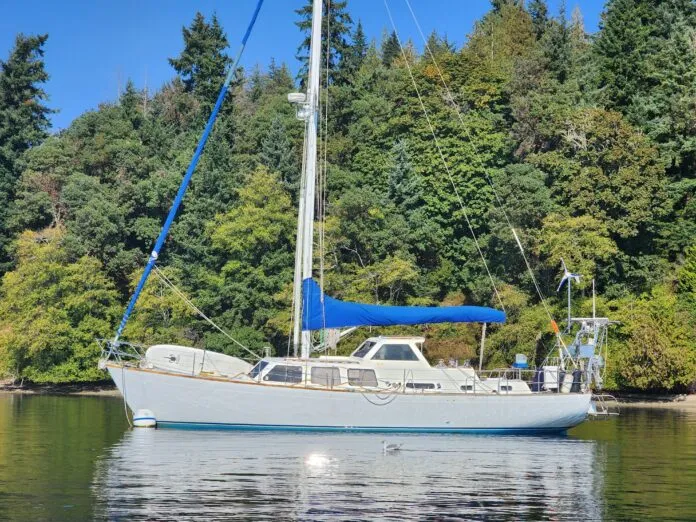
What kind of blue-water cruising sailboat should you consider when your thoughts turn offshore? We posed that question to Practical Sailor readers, and Puget Sound sailor Nelson Reynolds responded with an enthusiastic thumbs up for the Cal 2-46.
Not content to merely dip in a toe, Reynolds decided to go big, and when the 30,000-lbs. 70s vintage Bill Lapworth design came on the market, he pounced. We combined Reynolds’s owner’s report with Practical Sailor review for a complete look at this competent, capable voyager.
NELSON’S WISH LIST
In his own words: What do you do when you get the bug to get a blue-water boat? My personal quest began when I was a young teen. My dad and I would sit around and discuss the pros and cons of various boats in the latest Sail magazine and how wonderful it would be to live on one. You could say I come by my desire honestly. But for me, life kind of got in the way—wife, kids, career. You get the picture. Recently, however, I came to the realization that I could now make that dream happen. My criteria:
- A sailboat between 40- and 45-feet in length . Why? Since I tend to sail singlehanded or shorthanded, sail area needed to be manageable without a brawny crew, and I figured I could handle the sails on that size boat myself. I knew that I could manage sail area in stages by getting a ketch or a yawl, but I really didn’t want the added complexity of more than one spar, particularly in rapidly changing conditions.
- My preference was for a monohull rather than a catamaran or a trimaran. I find monohulls respond better to wind changes, and I don’t mind heeling.
- Stand-up headroom. Having to hunch over during long passages is an annoyance. I’m 6-feet tall, so that narrows boat selection. It has been my experience that boats in the mid 30-foot range seem a bit cramped. I know a lot of people have successfully lived on those boats, but in looking at extended time aboard, I felt that comfort was a priority.
- She must be big enough to comfortably live alone or with a few friends. A couple of decent-sized double berths would do the trick. I did not want to look at a lot of the charter boats, as they tend to try to squeeze in more berthing to accommodate more guests, though an extra cabin can always be used for storage.
- She must be able to handle the rigors of sailing offshore. Think about the ability to handle strong winds, and large seas.
My initial thoughts were:
- Beneteau – Heck when a lot of your friends have Beneteaus, why not join the crowd?
- Hunter 450 – I really liked my Hunter 28.5 and how she handled in a blow.
- Mid 40-foot Catalina
- Budget around $200K USD
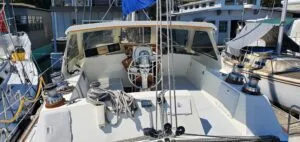
CHOICES NARROWED
Now to find a suitable boat. Searching different sites turned up a number of possibilities. The issue was to find a boat that I could look at. It seemed that once I found a potential candidate, it would be sold before I could schedule a trip to visit and examine her. Yeah, this was during the COVID boat buying boom. But one of the boats that came up within my search criteria was the Cal 2-46. That really looked like what I was looking for. Large master cabin with a double berth aft, double V-berth forward with an additional single berth, a decent galley, a huge saloon amidships, and a real engine room with workspace!! She seemed to be designed with me in mind. At 46-feet long, she was a bit larger than what I had been planning on, but the layout looked great.
Now the challenge was to find a boat that I could look at to see if it would actually fit me. Now it seemed that Neptune was against me. I would find a candidate, but it would be sold before I could go look at her. I lost track of how many boats I found that were gone before I could schedule a visit—the west coast, east coast, Hawaii … whatever. Finally, one came up on the listings that was available, and the broker said they didn’t have an offer. So, I made the trip up to look her over.
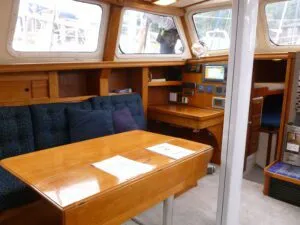
Frankly, once I stepped on the boat, I knew it was a really good choice for me. Not just the stand-up headroom front to back and the dedicated workspace/engine room. It just felt right. The broker had me look at several other boats in the same range while I was there. Some were very nice. Swan, Baltic, Tayana… They did have a Brewer aluminum hull that was VERY well equipped for offshore but was way too small. The others had way too many “warts” for me to consider. So, I scheduled a rigging survey and a boat survey. I can definitely recommend having the surveys done separately, as they involve different areas of expertise. She is also very well set up for single-handed sailing in that most of the control lines are led to the cockpit. Main and jib halyards, boom vang, outhaul and reefing lines are led to a winch on the cabin top. The primary and secondary sheet winches are also convenient to the helm position, as is the mainsheet winch. The spinnaker and secondary main and jib halyards are all on the mast but do have their own winches up there.
So now I am the proud owner of a Cal 2-46. The surveys did give me a bit of leverage to work the price down, but did I pay too much? Probably. But would the boat still be available? Probably not, given my history of having interesting boats snatched up off the market. Is the Cal a real blue-water boat? And the answer is unequivocally yes!
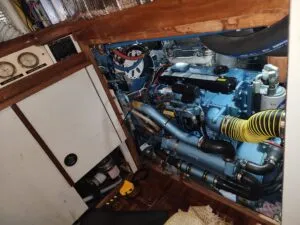
SUPERIOR OFFSHORE SAFETY
I really didn’t pay much attention to the characteristics of what was needed in a blue-water boat when I started my search, but I have learned what is important. I now pay attention to a couple of figures when evaluating boats. One is the capsize screening formula. This is a calculation regarding the ability of a boat to self-right in the case of a knockdown. The other is the comfort ratio, which gives relative stability in the presence of rough seas. As a reference, most offshore races don’t allow boats to enter with a capsize screening formula over 2.0. Now, there are many boats that have made extensive passages with numbers above that, but there is a risk. The comfort ratio is more subjective and not really a concern for racers, but that is where the heavier boats shine.
I would like to claim that I knew all about these ratios and formulas when I was looking for a boat, but that is the knowledge I acquired after the fact. But, when you start digging in, you see that the Beneteaus, Jeanneaus and the like are suitable for coastal cruising and suitable for the charter market in the Caribbean and the Med. Frankly, I recommend checking out the specs on Sailboatdata.com on any boat you are looking at for the type of sailing you are looking to do.
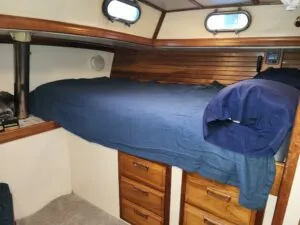
In general, heavy, long keel boats are more comfortable, but there are downsides as well. In general, they like to go in a straight line. Turning is an effort. And they can be a handful maneuvering in tight quarters.
So, let’s get to the positives and negatives of the Cal 2-46. Yeah, even though I love the Cal I have, there are things I think could be better. And, so there is no doubt about it, better means more money. 😉
TOP 5 REASONS I LIKE MY CAL 2-46
- It is a comfortable boat. It’s big enough inside and has enough ballast to be stable in most conditions. With a comfort ratio over 40 it is one of the more stable sailing yachts available. Keep in mind that this ratio pertains to sailing in rough seas, and not handling a rolly anchorage.
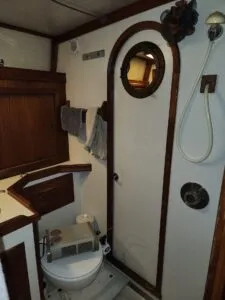
- The offshore stability is great, with a capsize screening formula of 1.6. This demonstrates a great ability to recover from a knockdown. The Cal compares favorably in this respect with other blue-water boats, such as the Island Packets or Krakens of similar size.
- Stand-up headroom. This boat has full stand-up headroom from the V-berth forward to the aft stateroom for a 6-foot plus person. Trust me, having to hunch over when walking through your boat gets old fast.
- Dedicated workroom/engine room for necessary engine and other maintenance activities while underway. This space offers a full workbench and open access to the engine and a lot of other things like filters and water pumps.
- Plenty of capacity. At least the one I purchased makes provision for 300 gallons of diesel fuel, 300 gallons of fresh water and a 100-gallon black water holding tank. So, I have close to a 2000-mile range under power alone.
TOP FIVE REASONS THE CAL 2-26 IS LESS THAN IDEAL
- It’s a heavy, long-keel boat. This means it is difficult to maneuver in tight areas. Like coming into a slip, especially with wind and current. The marina where I currently have her has significant current, so I’m reminded of this every time I go in or out. You are not going to spin this boat on a dime with rudder alone. You need to go out and practice slow-speed maneuvering under power using prop walk and wash. You especially need to know how much cross breeze will negate your prop walk.
- Also, as a long-keel boat, she really doesn’t like to go backward, which makes Med-style mooring a challenge. You can get her track in reverse if you have 2 knots of way on, but that also means you need to be able to stop that 30,000 pounds before you hit the dock.
- The sloop-rig version of the Cal 2-46 is rather underpowered relative to the size of the boat. You generally won’t be the first boat to the anchorage when traveling in a group. However, this also can mean she can handle higher winds. I did get a bit lucky on the boat I acquired. The previous owner replaced the mast with one that was 3-feet higher, which brought the sail area to displacement ratio up to a decent level. This might be less of an issue if you happen to get one of the ketch versions, but I never did see one of them listed during my 2-year search.
- The rudder is an unprotected spade. A lot of long keel boats have the rudder attached at the back side of the keel which provides substantial protection but does limit the effectiveness when turning. Other long-keel boats mount the rudder to a skeg to provide some protection. The Cal has neither, so that is one thing you need to be cognizant of when sailing through areas with debris, etc.
- The high freeboard and center cockpit design really make it difficult to pick up a mooring, especially single-handed. Maybe I’m being picky but picking up the mooring ball chain about 6 feet up forward to run the lines through is a workout. One of the alternatives I have taught some fellow sailors is to pick up the mooring off the stern. I the case of the Cal 2-46 that would save about a foot or so on the lift, but with the center cockpit design, it is still a bit of a hike to get from the helm to the stern. Basically, I provide entertainment for nearby boats when I pick up a mooring single-handed with wind and current.
One additional item that could go in both the plus and the minus columns is the huge window area in the saloon. This makes the saloon extremely bright and open. However, having the large window area as opposed to more normal portlights means you must be cognizant of large, breaking seas.
The bottom line is I’m very happy with my purchase of this Cal 2-46. I got lucky in that the previous owners treated her well. An added bonus: I got to discover the Pacific Northwest. The Puget Sound and the San Juan Islands. Fabulous!!
RELATED ARTICLES MORE FROM AUTHOR
Your faulty program leaves me stranded every time I try to continue an article. Get your act together or get a real job. This is really unacceptable.
LEAVE A REPLY Cancel reply
Log in to leave a comment
Latest Videos
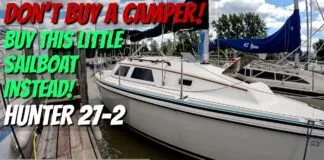
The Perfect Family Sailboat! Hunter 27-2 – Boat Review

Pettit EZ-Poxy – How to Paint a Boat

The Boat From True Spirit – Sparkman & Stephens

Top 5 Boat Hacks – Boat Maintenance Tips and Tricks
Latest sailboat review.
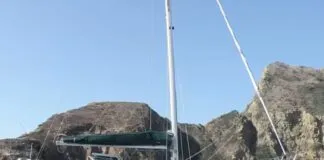
- Privacy Policy
- Do Not Sell My Personal Information
- Online Account Activation
- Privacy Manager
Review of Cal 2-46

Basic specs.
The hull is made of fibreglass. Generally, a hull made of fibreglass requires only a minimum of maintenance during the sailing season.
The boat is equipped with a galley, 606.0 liter fresh water capacity, toilet facility and 45.0 liter waste water capacity.
The boat equipped with a ketch rig. A ketch rig is generally considered easier to handle, because the sails are smaller, and because it can sail on most points to the wind with one sail completely taken down for repair or while reefing. The sail configuration of a ketch allows for better comfort and stability when sailing downwind or on a broad reach.
The Cal 2-46 is equipped with a fin keel. A boat with a fin keel is more manoeuvrable but has less directional stability than a similar boat with a full keel.
The boat can enter most marinas as the draft is just about 1.52 - 1.62 meter (4.99 - 5.29 ft) dependent on the load. See immersion rate below.
Cal 2-46 is typically equipped with an inboard Perkins 4.236 M diesel engine at 85 hp (63 kW). Calculated max speed is about 7.7 knots
The fuel tank, which is made of steel, has a capacity of 1022.0 liters (269 US gallons, 224 imperial gallons).
Sailing characteristics
This section covers widely used rules of thumb to describe the sailing characteristics. Please note that even though the calculations are correct, the interpretation of the results might not be valid for extreme boats.
What is Capsize Screening Formula (CSF)?
The capsize screening value for Cal 2-46 is 1.61, indicating that this boat could - if evaluated by this formula alone - be accepted to participate in ocean races.
What is Theoretical Maximum Hull Speed?
The theoretical maximal speed of a displacement boat of this length is 8.2 knots. The term "Theoretical Maximum Hull Speed" is widely used even though a boat can sail faster. The term shall be interpreted as above the theoretical speed a great additional power is necessary for a small gain in speed.
The immersion rate is defined as the weight required to sink the boat a certain level. The immersion rate for Cal 2-46 is about 291 kg/cm, alternatively 1633 lbs/inch. Meaning: if you load 291 kg cargo on the boat then it will sink 1 cm. Alternatively, if you load 1633 lbs cargo on the boat it will sink 1 inch.
Sailing statistics
This section is statistical comparison with similar boats of the same category. The basis of the following statistical computations is our unique database with more than 26,000 different boat types and 350,000 data points.
What is Motion Comfort Ratio (MCR)?
What is L/B (Length Beam Ratio)?
What is a Ballast Ratio?
What is Displacement Length Ratio?
Maintenance
When buying anti-fouling bottom paint, it's nice to know how much to buy. The surface of the wet bottom is about 46m 2 (495 ft 2 ). Based on this, your favourite maritime shop can tell you the quantity you need.
If you need to renew parts of your running rig and is not quite sure of the dimensions, you may find the estimates computed below useful.
| Usage | Length | Diameter | ||
| Jib sheet | 13.9 m | (45.5 feet) | 16 mm | (5/8 inch) |
| Genoa sheet | 13.9 m | (45.5 feet) | 16 mm | (5/8 inch) |
| Mainsheet | 34.7 m | (113.8 feet) | 16 mm | (5/8 inch) |
| Spinnaker sheet | 30.5 m | (100.1 feet) | 16 mm | (5/8 inch) |
This section is reserved boat owner's modifications, improvements, etc. Here you might find (or contribute with) inspiration for your boat.
Do you have changes/improvements you would like to share? Upload a photo and describe what you have done.
We are always looking for new photos. If you can contribute with photos for Cal 2-46 it would be a great help.
If you have any comments to the review, improvement suggestions, or the like, feel free to contact us . Criticism helps us to improve.

Fin w/spade rudder
Specifications CAL 2-46
Home - Sailboat Listings 1971 - 45.50 ft / 13.87 m - C. William Lapworth - Jensen Marine (USA)

CAL 2-46 Sailboat Data
Hull Type: Fin w/spade rudder Rigging Type: Masthead Sloop LOA: 45.50 ft / 13.87 m LWL: 37.50 ft / 11.43 m S.A. (reported): 781.00 ft² / 72.56 m² Beam: 12.50 ft / 3.81 m Displacement: 30,000.00 lb / 13,608 kg Ballast: 8,000.00 lb / 3,629 kg Max Draft: 5.00 ft / 1.52 m Construction: FG First Built: 1971 Last Built: 1975 # Built: 129 Builder: Jensen Marine (USA) Designer: C. William Lapworth
Information from sailboatdata.com .
Type Engine: Diesel Fuel: 270 gals / 1,022 L Water: 170 gals / 644 L Hull Speed: 8.21 kn
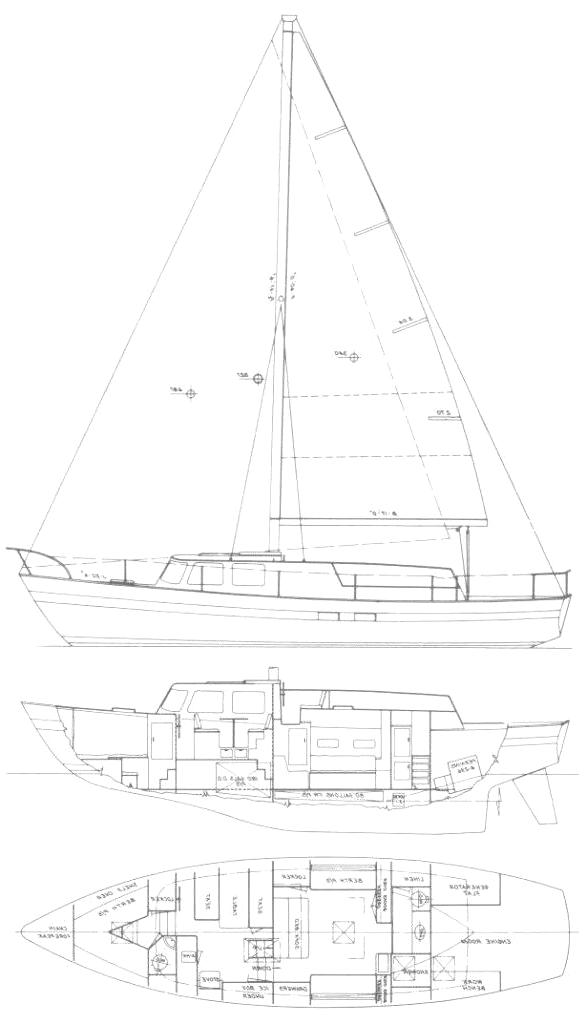
× You are using an outdated browser. Please upgrade your browser to improve your experience.
We Ship Worldwide! | FREE SHIPPING! for US Continental orders over $99. Click for details.

Shopping Cart
Your cart is currently empty..
FREE SHIPPING! for US Continental orders over $99 click for details
Cal 46-2 - Sailboat Data, Parts & Rigging

Sailboat data, rig dimensions and recommended sail areas for Cal 2-46 sailboat. Tech info about rigging, halyards, sheets, mainsail covers and more.
Sailboat Data directory for over 8,000 sailboat designs and manufacturers. Direct access to halyards lengths, recommended sail areas, mainsail cover styles, standing rigging fittings, and lots more for all cruising and racing sailboats.
MAURIPRO Sailing offers a full range of sailboat and sailing information to help you find the correct sailboat part, one that properly would fit your sailboat and sailing style. Our sailor's and sailboat owner support team are ready to talk with you about your specific sailing needs, coming regatta, or next sailing adventure.
From all at MAURIPRO, let's Go Sailing!
Copyright © 2024 MAURIPRO Sailing LLC.
CAL 2-46 Detailed Review
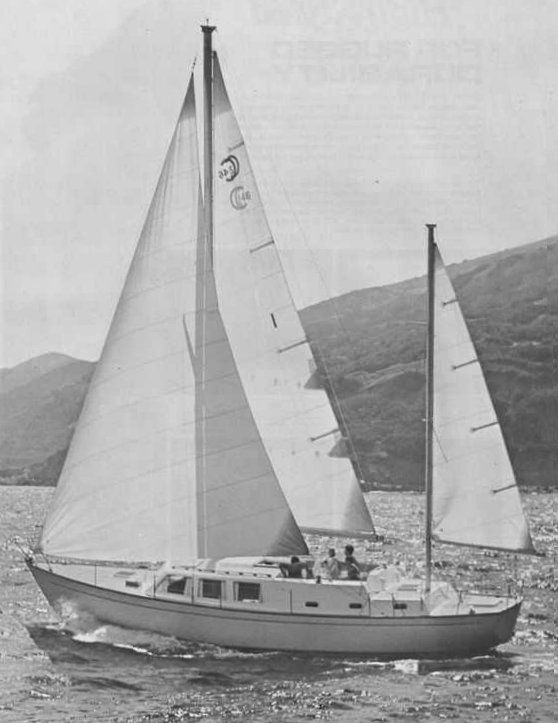
If you are a boat enthusiast looking to get more information on specs, built, make, etc. of different boats, then here is a complete review of CAL 2-46. Built by Jensen Marine/Cal Boats and designed by C. William Lapworth, the boat was first built in 1971. It has a hull type of Fin w/spade rudder and LOA is 13.87. Its sail area/displacement ratio 13.00. Its auxiliary power tank, manufactured by Perkins, runs on Diesel.
CAL 2-46 has retained its value as a result of superior building, a solid reputation, and a devoted owner base. Read on to find out more about CAL 2-46 and decide if it is a fit for your boating needs.
Boat Information
Boat specifications, sail boat calculation, rig and sail specs, auxillary power tank, accomodations, contributions, who designed the cal 2-46.
CAL 2-46 was designed by C. William Lapworth.
Who builds CAL 2-46?
CAL 2-46 is built by Jensen Marine/Cal Boats.

When was CAL 2-46 first built?
CAL 2-46 was first built in 1971.
How long is CAL 2-46?
CAL 2-46 is 11.43 m in length.
What is mast height on CAL 2-46?
CAL 2-46 has a mast height of 12.22 m.
Member Boats at HarborMoor
| ||||||||||||||||||||||||||||||||||||||||||||||||||||||||||||||||||||||||||||||||||||||||||||||||||||||||||||||||||||||||||||||||||||||||||||||||||||||||||||||||||||||||||||||||||||||||||||||||||||||||||||||||||||||||||||||||||||||||||||||||||||||||||









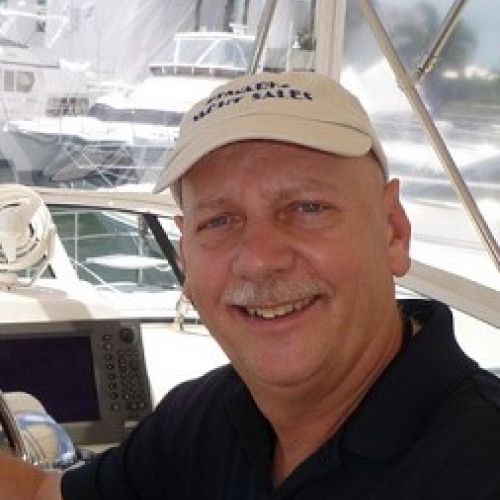




















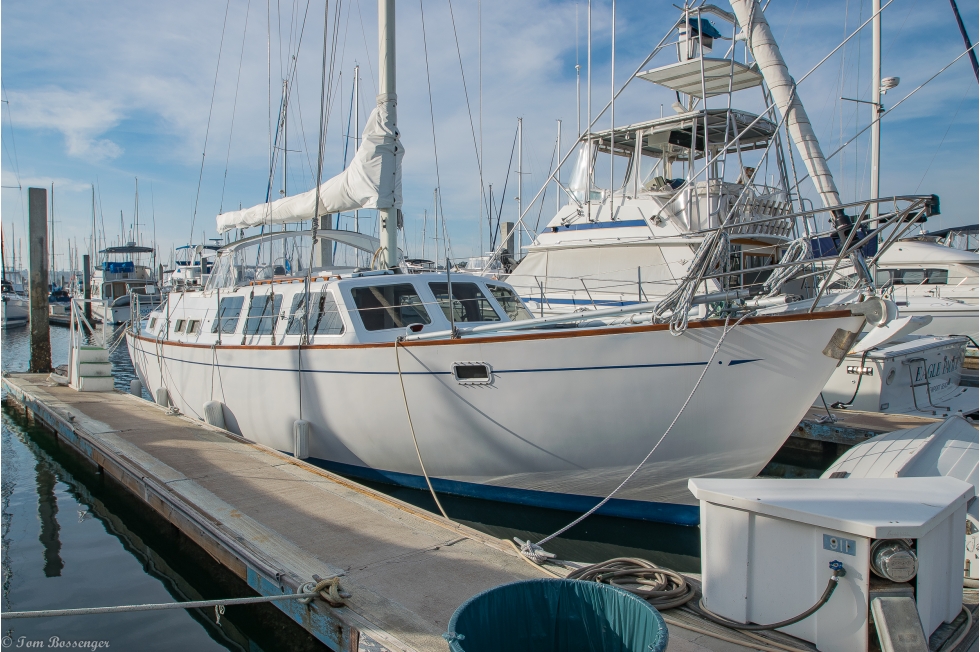

COMMENTS
Notes. A development from the earlier CAL 46 MS (CAL CRUISING 46). The differences between this and the earlier version: The engine room has been moved forward to midships, the aft cabin moved further aft. The main salon and the forward cabin have been enlarged. This 'new' design, proved to be a huge success with 95 built.
The Cal 2 46 is a 45.5ft masthead sloop designed by C. William Lapworth and built in fiberglass by Jensen Marine/Cal Boats between 1971 and 1975. ... The data on this page has been derived from different sources but a significant part is attributed to sailboatdata.com. We thank them for their encouragements and friendly collaboration.
The Cal 46 was introduced in 1967. One reader said he thinks about 10 were built. For several years it was called the Cal Cruising 46. The Cal 2-46, with a redesigned deck, cockpit and interior layout, succeeded it from 1973 until 1976. The Cal 3-46, virtually the same as the 2-46 except for some minor interior changes, was built in 1977 and 1978.
Cal 2-46 is a 45′ 6″ / 13.9 m monohull sailboat designed by C. William Lapworth and built by Jensen Marine/Cal Boats between 1971 and 1975.
We posed that question to Practical Sailor readers, and Puget Sound sailor Nelson Reynolds responded with an enthusiastic thumbs up for the Cal 2-46. Not content to merely dip in a toe, Reynolds decided to go big, and when the 30,000-lbs. 70s vintage Bill Lapworth design came on the market, he pounced. We combined Reynolds's owner's report ...
The Cal 2-46 is extremely stable and sea-kindly. She is easily driven -- her big 85 horsepower Perkins diesel provides a steady 8.5 knots with a cruising range of 1200 miles. And she has excellent sailing characteristics -- a breeze provides an easy 8.5 knots. The cockpit and deck of the 2-46 are laid out for easy handling and large areas of ...
The DL-ratio for Cal 2-46 is 253 which categorizes this boat among 'light crusers & offshore racers'. 42% of all similar sailboat designs are categorized as heavier. A heavy displacement combined with smaller water plane area has lower acceleration and is more comfortable.
CAL 2-46 Sailboat Data Hull Type: Fin w/spade rudder Rigging Type: Masthead Sloop LOA: 45.50 ft / 13.87 m LWL: 37.50 ft / 11.43 m S.A. (reported): 781.00 ft² / 72.56 m² Beam: 12.50 ft / 3.81 m Displacement: 30,000.00 lb / 13,608 kg Ballast: 8,000.00 lb / 3,629 kg…
The CAL 2-46 yacht was built for distance. An 85hp Perkins diesel and tanks for 135 gallons of fuel provide a steady 8-knot cruising speed. A cruising range of 1,200 miles under power alone. The CAL 2-46 will also cruise at an honest 8 knots under sail. In fact, the Class Association tells us five 2-46's are already on their way around the ...
Sailboat data, rig dimensions and recommended sail areas for Cal 2-46 sailboat. Tech info about rigging, halyards, sheets, mainsail covers and more.
You must be logged in to create new topics. Log In. Username:
CAL 2-46 Detailed Review. If you are a boat enthusiast looking to get more information on specs, built, make, etc. of different boats, then here is a complete review of CAL 2-46. Built by Jensen Marine/Cal Boats and designed by C. William Lapworth, the boat was first built in 1971. It has a hull type of Fin w/spade rudder and LOA is 13.87.
46' cal 246 deltaville, Virginia Asking $68,000. 44.6' pearson countess Saint Petersburg, Florida Asking $65,000. 27' Cornish Crabber Gaff rigged 22 Stuart, Florida Asking $25,000. 37' Pacific Seacraft 37 Bocas del Toro Panama, Asking $129,500. 13' RS Aero 9 -7 Cedar Point Yacht Club - Westport CT, Connecticut
Find CAL 2 46 boats for sale in your area & across the world on YachtWorld. Offering the best selection of CAL boats to choose from.
The boat went through a third iteration in the mid-'70's that included smaller cabin windows and other changes to the interior. This was the CAL 3-46 (or "Mark III's"). All the 46's used the same hull. (see CAL 2-46) (Previously listed as CAL 46 MS) Suggest Improvements. Source: sailboatdata.com / CC BY.
Know freinds that sailed with a couple that circumnavigated over 10 years with a Cal 2-46. You should join the cal club here on sailnet. Seasoned Cal owners who can tell you anything you would like to know. FYI - Bill Lapworth (designer of Cal''s) retired on a 2-46.
When sales of this first version of Cal's 46 foot cruising ketch proved disappointing, (18 built) it was decided to completely redesign the interior. For the updated model (called the CAL 2-46), the engine room was moved forward, the aft cabin even further aft. The main salon and the forward cabin were enlarged. Bill Lapworth […]
Molly J is a unique highly modified Cal 2-46 that has been converted from a valid ocean cruiser, by original design, into a perfect cruising boat for anything from coastal cruising to circumnavigating. Over the past 5 years, the current owner has renewed virtually all systems, total rewire, total plumbing, total hull and cabin restoration, new rigging and sail, and all accessories. The amount ...
1974 Cal 2-46 Center Cockpit Broker's Comments. Volante III is a beautiful 1974 Cal 2-46 Center Cockpit located in Venice, FL. She has been well maintained by her current owner of 23 years, and she is in excellent overall condition. Her 12' 6" Beam creates a spacious Galley to Starboard and Saloon with Settee and Dining area to Port.
Founded by Jack Jensen and originally located at Costa Mesa, CA. The company first sold the centerboard LAPWORTH 24 designed by Bill Lapworth. The Lapworth's 24 sold well. The name was first changed to CALIFORNIA 24 and then CAL 24. The name Cal stuck with the company until it closed in 1986. The 24 was a success and Jensen hired Lapworth to design several more yachts including a 27 foot pop ...
1974 CAL 2-46. US$117,245. Raiatea Yacht | Noumea, New Caledonia. Request Info. <. 1. >. * Price displayed is based on today's currency conversion rate of the listed sales price. Boats Group does not guarantee the accuracy of conversion rates and rates may differ than those provided by financial institutions at the time of transaction.
1975 CAL 2-46. US$70,000. SeaKist Yacht Sales | Rio Dulce, Guatemala. Request Info; 1974 CAL 2-46. US$119,284. Raiatea Yacht | Noumea, New Caledonia < 1 > * Price displayed is based on today's currency conversion rate of the listed sales price. Boats Group does not guarantee the accuracy of conversion rates and rates may differ than those ...
Descriptions. 1977 Cal 2-46 Sailboat For Sale in San Diego. Freya is a Cal 2-46 with a custom interior lay out modeled after the later Cal 3-46. This resulted in a yacht that preserved the wide open "deck saloon"windows of the 2-46 and combined it with the later "galley down" configuration of the 3-46 which significantly opens up the main cabin ...